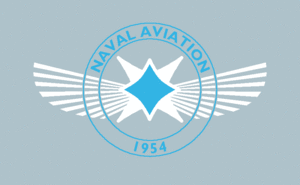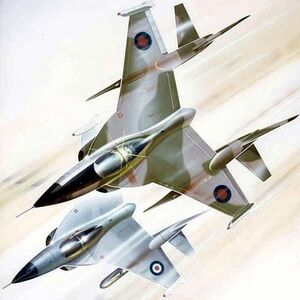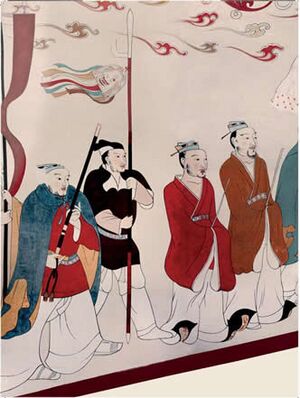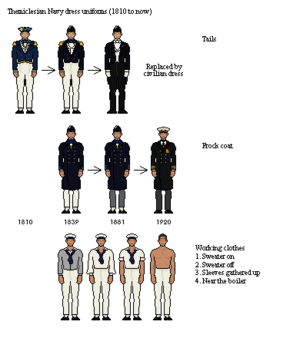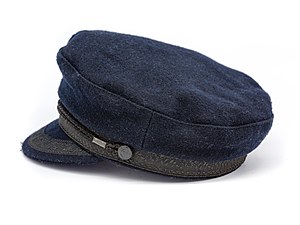Themiclesian Navy: Difference between revisions
| (4 intermediate revisions by the same user not shown) | |||
| Line 9: | Line 9: | ||
| role = | | role = | ||
| size = 41,672 active<br />14,233 reserve | | size = 41,672 active<br />14,233 reserve | ||
| command_structure = [[Ministry of Defence (Themiclesia)|Ministry of Defence]] | | command_structure = [[Ministry of Defence (Themiclesia)|Ministry of Defence]] | ||
| garrison = Prat Building, [[Kien-k'ang]] | | garrison = Prat Building, [[Kien-k'ang]] | ||
| garrison_label = Headquarters | | garrison_label = Headquarters | ||
| Line 89: | Line 89: | ||
The NSF received funding sufficient for the maintenance of their vessels but seldom for the purchase of new ships. This situation changed for the only time between 1852 and 1865, during which a Rajian invasion then Columbian invasion was feared to take place by sea. The NSF purchased several new {{wp|ships-of-the-line}} at the beginning of 1853 and coastal {{wp|ironclad}}s towards the end of this era and into 1860–61. Further coastal ships were purchased between 1862–1864. After the [[Compromise of Sngrak-tju]] in 1857, threat of Rajian invasion gradually subsided, leaving a partly-modern fleet. Fears then turned towards an OS invasion, which was deemed existential by some, should the slave-holding side emerge victorious; this fear occasioned the purchase of the ironclad steam ships for coastal defence. Timing of the ship purchases could hardly be less favourable, as wooden ships-of-the-line were quickly phased out during the following decade. Nevertheless, the Navy would continue using these ships well into the 20th century, a situation they could not anticipate. Nevertheless, the Navy continued to press for funding under the dubious pretext of OS aggression, to which the government responded inconsistently. In the aftermath of the great flood of 1894, the government found itself hamstrung for funds and resolved to solve all matters with the OS diplomatically. | The NSF received funding sufficient for the maintenance of their vessels but seldom for the purchase of new ships. This situation changed for the only time between 1852 and 1865, during which a Rajian invasion then Columbian invasion was feared to take place by sea. The NSF purchased several new {{wp|ships-of-the-line}} at the beginning of 1853 and coastal {{wp|ironclad}}s towards the end of this era and into 1860–61. Further coastal ships were purchased between 1862–1864. After the [[Compromise of Sngrak-tju]] in 1857, threat of Rajian invasion gradually subsided, leaving a partly-modern fleet. Fears then turned towards an OS invasion, which was deemed existential by some, should the slave-holding side emerge victorious; this fear occasioned the purchase of the ironclad steam ships for coastal defence. Timing of the ship purchases could hardly be less favourable, as wooden ships-of-the-line were quickly phased out during the following decade. Nevertheless, the Navy would continue using these ships well into the 20th century, a situation they could not anticipate. Nevertheless, the Navy continued to press for funding under the dubious pretext of OS aggression, to which the government responded inconsistently. In the aftermath of the great flood of 1894, the government found itself hamstrung for funds and resolved to solve all matters with the OS diplomatically. | ||
== | ==Structure== | ||
[[File:Themi_naval_aviation_4.gif|thumb|Emblem of the Naval Aviation department]] | [[File:Themi_naval_aviation_4.gif|thumb|Emblem of the Naval Aviation department]] | ||
The Themiclesian Navy is overseen by the [[Admiralty Department (Themiclesia)|Admiralty Department]], which has been a division of the [[Ministry of Defence (Themiclesia)|Ministry of Defence]] following the merger of the defence ministries (War, Admiralty, and the military half of Air) in 1970. The Admiralty Department is both a [[Principal counsels and ceremonial departments|medieval]] and modern government department. The Admiralty Department is responsible for the navy's finance, procurement, recruitment, training, and operations, though the [[Standing Committee on Military Operations]] is in direct charge of some operations involving the navy's personnel and assets. | |||
The Admiralty Department is led by a panel of officers called the [[Barons of the Navy]], who are called thus because it was formerly customary to elevate senior officers to [[Peerage of Themiclesia|baronial rank]]; in modern practice, the Barons of the Navy are not necessarily or often actual barons, not dissimilar to the ranking officers of the [[Exchequer Department (Themiclesia)|Exchequer Department]]. The number of Barons overseeing the navy is not fixed but usually fluctuates between seven and twelve; some are assigned to permanent portfolios in the Department (such as finance or operations), and others (called Lay Barons) to temporary responsibilities designated by the government. The Barons are part of the [[Themiclesian Ministry|Ministry]] and can be held politically responsible for their decisions. | |||
Most of the navy's ships are part of the Consolidated Fleet, which is commanded by the its Admiral. Ships are grouped, according to mission and location, into flotillas and squadrons, each commanded by their respective junior admirals. | |||
==Vessels== | ==Vessels== | ||
===Light aircraft carriers=== | ===Light aircraft carriers=== | ||
[[File:GIA_Goshawk_1.jpg|thumb|Fighter jets on SS Ghwra]] | |||
*'''SS Mngê''' (兒舶): {{wp|light aircraft carrier}} capable of carrying eleven fighter jets and eleven large helicopters. | *'''SS Mngê''' (兒舶): {{wp|light aircraft carrier}} capable of carrying eleven fighter jets and eleven large helicopters. | ||
*'''SS Ghwra''' ( | *'''SS Ghwra''' (邘舶): ''do.'' | ||
===Destroyers=== | ===Destroyers=== | ||
| Line 141: | Line 146: | ||
*'''SS Nu''': | *'''SS Nu''': | ||
*'''SS ′I''': | *'''SS ′I''': | ||
*'''SS | *'''SS Skremp''': | ||
*'''SS Staws''': | *'''SS Staws''': | ||
*'''SS Laq''': | *'''SS Laq''': | ||
*'''SS R′at''': | *'''SS R′at''': | ||
===Missile boats=== | |||
*'''SS Kjal''': | |||
*'''SS Per''': | |||
*'''SS Kangs''': | |||
*'''SS Lirl''': | |||
*'''SS Gamp''': | |||
*'''SS Bis''': | |||
*'''SS To''': | |||
*'''SS Kro''': | |||
*'''SS Part''': | |||
*'''SS Mring''': | |||
*'''SS Driks''': | |||
*'''SS Lei''': | |||
*'''SS Dem''': | |||
*'''SS Dam''': | |||
*'''SS Ngat''': | |||
*'''SS Nhips''': | |||
*'''SS M′reng''': | |||
*'''SS Puk''': | |||
*'''SS Du''': | |||
*'''SS Daks''': | |||
*'''SS Lap''': | |||
*'''SS Kwen''': | |||
*'''SS Qens''': | |||
*'''SS Ghor''': | |||
*'''SS ′Rip''': | |||
*'''SS Stap''': | |||
*'''SS Mnga''': | |||
*'''SS Nei''': | |||
*'''SS Prang''': | |||
*'''SS Sing''': | |||
===Minesweepers=== | |||
===Minehunters=== | |||
===Minelayers=== | |||
==Culture== | ==Culture== | ||
Latest revision as of 02:09, 15 November 2021
| Themiclesian Navy | |
|---|---|
| 航 (gang, lit. "fleet") | |
 War jack of the Themiclesian Navy | |
| Founded | 17 February 762 |
| Country | Themiclesia |
| Branch | Navy |
| Size | 41,672 active 14,233 reserve |
| Part of | Ministry of Defence |
| Headquarters | Prat Building, Kien-k'ang |
| Colors | Aqua |
| March | the navy don't march |
| Engagements | |
| Commanders | |
| Secretary of State for Defence | Sdem Tsots |
| President-Baron of the Admiralty | Krang′ ′seng |
The Themiclesian Navy (震旦航, terh-tans-gang), or officially the Navy (航, gang) is Themiclesia's military force responsible for operations at sea and in certain terrestrial areas. It is headed by the Under-Secretary of State for the Navy, a junior minister under the Secretary of State for Defence. The Navy possesses numerous corvettes, destroyers, and other marine and freshwater vessels. It traces its origins to the early 9th century and is the principal arm of Themiclesian forces operating in the high seas, as well as the protection of her interests abroad.
Name
The name Themiclesian Navy is an exonym applied by foreign states to the naval forces of Themiclesia. Domestically, it is simply called the gang (航), literally "fleet". The nationality is not mentioned, since the name of the navy, as an organic entity, is directly derived from its parent department, the Bureau of Fleets. For much of the navy's history, it was the only standing national navy known to Themiclesia; when disambiguation with foreign navies was required, the Themiclesian one was often called ngar′-gang (我航), literally "one's fleet".[1] The phrase tjelh-tanh-gang (震旦航), "Themiclesian navy" is virtually unheard of until the 20th century.
The word gang (航) is a phono-sematic compound, consisting of the semantic tju (舟), "boat", and the phonetic kangh (亢), which is written purely for its phonetic value. gang can be used as a verb and noun in Shinasthana. As a verb, it means to sail or cross, and as a noun, it means something which sails or crosses, from which the meaning of "fleet" emerges. Incidentally, it also means pontoon bridge, which consists of boats strung together and surfaced as a bridge across a river. The pontoon bridge (removed for a brick bridge in 1842) across the southern gate of Kien-k'ang is named tjo-tsjakw-gang, the "pontoon bridge of vermillion birds".
Definitions and statutory structure
Statutorily, there is no single organization called "the Navy", which is an umbrella term of several organizations that, for historical and operational reasons, have shared a close relationship or leadership. In the broadest definition, "the Navy" can refer to the entire naval establishment, including the civilian Navy Ministry; in the literal Shinasthana definition, it includes only the military organizations that were under the Bureau of Fleets. While the term can be used in any sense in between, the broader definition is more common in modern writing. In this article, as in some references, the proper noun Navy refers to the narrow definition, as a direct translation of Shinasthana gang (fleet), while the common noun navy shall refer to the entire naval establishment.
Themiclesia's constitution does not permit military organizations to exist independently: all are nominally part of some department of the outer court, which are answerable to parliament, directly or indirectly. The navy's senior officers (such as captains and their mates), had been ex-officio civil administrators, and non-officers were subjects in service to the state through administrators. While the professionalization of the Navy has been steadily eroded the equivalence between naval officer and civil servant since the 11th century, parliament only changed the legal status of the navy's officers in the 19th. The civilian "shell" of the armed forces has no discernable function today, but budgets are still passed in terms of civil administration, and the Admiralty remains, on a legal level, civilian advisory staff to the Director of Fleets, which is now a sinecure. Orders from the Navy Ministry were officially phrased as the emperor's (as chief of all administrators) commands, with the advice of the Secretary of State of the Navy, who in turn is advised by the Consolidated Naval Staff, to the Bureau of Fleets, which implements it through the Admiralty. Due to operational needs, the Admiralty possessed liaison offices with the five other civilian administrations, which enabled it to preside over them in certain ways, making the Bureau of Fleets primus inter pares between the bureaus, and the Admiralty their de facto leadership as far as naval operations are concerned.
The following are the civilian administrations under which the Navy, in the broad sense, exists:
- Department of Fleets (航令, gang-ringh) — the Consolidated Fleet's and the Inland Fleet's assets and their operations. The Great Admiralty (航中記室), technically a staff office to the Director of Fleets, is in charge of operations by Consolidated Fleet; the Director of Fleets is constitutionally a subordinate of the Privy Treasurer, though the latter official in modern centuries plays no material role. The Bureau of Fleets is the default administration into which new naval organizations are placed, such as the Department of Naval Aviation (航空).
- Department of Naval Engineers (海寺工令, m′e′-lje-kong-ringh) — Naval Procurement Service and several institutions relating to research and development
- Department of Passengers (冗人令, njung′-njing-ringh) — traditionally, roles that cannot be filled with impressed sailors (e.g. financial, clerical, legal, medical) and are not related to construction or manufacture are classified into the Bureau of Passengers; it is also responsible for certain instances of impressment and the Themiclesian Marine Corps
- Department of Ports and Passes (關津令, kron-tsjin-ringh) — Management of revenues arising from leases and other sources
- Department Impressment (海官令, m′e′-kwal-ringh) — Levying sailors from merchant fleets, recruitment of professional sailors, and the sailor schools
- Department of West Woods (西章令, sner-tjang-ringh) — Levying shipwrights for shipbuilding, their compensation and access to state forests
History
Pre-modern history
The naval history of Themiclesia can be traced to the 2nd and 3rd centuries, when settlers in what is now central Themiclesia began to expand outwards, ousting native societies that inhabited the surrounding regions. On land, the Tsjins state employed cavalry and chariotry to great effect, but in what is today Gwje'-ding, the aboriginals have mastered the use of canoes and harrassed Themiclesian troops that could not fight on water. A similar but direr situation existed in the southwest, where the Prjin-aboriginals exploited the Inland Sea to great effect, emerging from the coast and launching attacks on settlers without warning. An advantage that such aboriginals held was mobility and security from assault if retreated to deeper parts of the water. These factors conditioned the creation of ship-based forced to tackle such resistance. In 321, the "navy" department (水兵曹, sljui-prjang-dzaw) was created in the Ministry of War. Like the cavalry department, it was a locale-specific branch, recruiting only in prefectures where it was necessary to field ships; it manufactured, and sometimes commandeered, vessels and trained its soldiers separately from the other branches. The organizational successor of this navy was the Themiclesian Army's Lake Fleet, which was transferred to the Navy in the 19th century.
The ancestor of the Navy was established only later, tied to Themiclesia's foreign policy objectives. Even though hostilities sometimes broke out in early history between the emerging Themiclesian state and various Columbian native societies, it is ultimately the need to suppress piracy and protect merchant interests that backed the navies' existence. Themiclesia imported materials such as jewels, furs, wooden containers, and pigments from the Columbian natives and exported fabrics, porcelains, and other crafts to them. A source of coastal disorder that proved persistent was Maverican pirates, who looted the coastal settlements and raided merchant fleets. Seafaring Columbian natives also, at times, posed threats to Themiclesian merchant vessels. A second radix of Themiclesia's naval tradition is occasional naval conflicts with Maverican fleets, the first recorded instance of which occurred in 491.
Initially, warships were converted from merchant ships and escorted them across the Halu'an Sea and later to Meridia. The warships were manned by guilds of merchants in Themiclesia, providing the warships' complements; after the 5th century, the state appointed superintendants to oversee their activities, but ties with merchant fleets remained close. By the 8th century, maritime trade had grown in volume such that escorting specific merchant fleets became unfeasible; instead, the government took over the naval operation and launched regular circuits of warships along the coast of the Halu'an, the Columbian coast, and the northern coast of Meridia. The organizational link with trading guilds became a financial one: Themiclesia used revenues from customs and other levies to fund its navies. In 854, Themiclesia divided its fleet into two circuits, one for the coast of the Halu'an Sea, named the North Sea Fleet (北航, pek-gang), and the other for all other coasts, for the South Sea Fleet (南航, nem-gang). The SSF had its home port first in La Rivera then moved it to Portcullia in 1010.
During the 9th through 14th centuries, the SSF frequently clashed with Rajian raiders; these occurred before the advent of gunpowder. In 1323, the SSF was defeated by the gunpowder-equipped Menghean fleet in the Battle of Portcullia; the new technology was quickly adopted by the SSF and the NSF in but a few years, though with very little consideration over its tactics.
The loss of Portcullia resulted first in a search for an alternative base, then a second clash with the Menghean Yi navy in 1352. Themiclesia made a temporary base, in 1325, on a small island on the coast of today Naseristan. While the use of gunpowder remained largely at the same level, both fleets were better armed, fortified with thickened hulls, and more primed for battle. However, the Mengheans still overcame the Themiclesians after the initial barrage of cannonfire subsided, and both fleets engaged for boarding action. The Menghean fleet's key advantage over the Themiclesian was in strategy. Knowing that the Themiclesian fleet was not fatally hurt by the defeat at Portcullia and will regain its presence, the Menghean commander prepared his fleet for a decisive battle, while his opponent prepared for a long-term voyage along the Meridian coast. The Mengheans adopted a more aggressive fleet formation, able to concentrate diffuse fire more effectively, while the Themiclesians sailed in a school formation. Portcullia and a more constrained mission (up to two months from port) allowed far more fighting men, while the Themiclesians provisioned for up to two years. This resulted in a crushing defeat that sank 114 Themiclesian warships amongst the 150 lost; 17 sailed home. It has been commented that the Menghean fleet behaved as a co-ordinated whole, while the Themiclesian one was merely an aggregation of ships, expecting to engage on that level.
The defeat at Naseristan had profound effects on the Themiclesian Navy and its relationship with society and state. By this point, it had survived the collapse of two dynasties and was regarded as a permanent institution. Maritime historian N. Nielsen believes that "through the shock of Portcullia and Naseristan, the Themiclesian Navy was weaned off its merchant roots and came to accept that its future business will not be the suppression of pirates and protecting trade, but manifestation of its country's military power, just like the army, but on water". From a financial perspective, further conclusions could be drawn, according to B. Larter, who writes,
[the] Themiclesian navy up to Naseristan has a strong fiscal basis to justify its existence. By controlling key trading posts, sailing routes, and suppression of pirates, it was able to generate revenue to support the state. This is not to say it was always a net cashflow-positive organization, but its directive was to protect activities that generated revenue. As fierce as pirates at sea and bandits on land may be, the navy never fought an enemy with the backing of state power and resource; that was the realm of diplomacy, at this distance from home. But Menghe's use of its navy as an arm of its war machine, without a clear fiscal incentive, to assert the dominance of one state over another, changes this aforementioned relationship. From Naseristan on, it is not the navy that funds the state, but the state that funds the navy. From Naseristan on, the navy does not protect the commercial traffic and revenue but destroy rivals from adversarial states. From Naseristan on, the navy did not fight for reasons of finance, but reasons of power.
The first major naval conflicts the Themiclesians fought with the assistance of gunpowder were against the Kingdom of Sylva, who first expressed interest in the southern tip of Columbia in the 1400s. The SSF were again defeated in 1482, forcing them to relocated their home port from near San Alvarez to the mouth of the river adjoining La Riviera. Meanwhile, the NSF found it increasingly difficult to ensure peace in the Halu'an Sea due to overland incursion by Rajian settlers, who populated the north of Columbia. In 1607, the SSF were defeated by the Sylvans again. However, given the rise in Columbian population and propensity towards commerce, Themiclesian merchants began to prefer trading at home rather than sailing out to sea; as a result, the navies were both recalled and placed at home in 1610. Both underwent reductions in scale and armaments. In the 1700s, the NSF were charged with protecting coastal waters for the most part, while the SSF participated in enforcement of trade tariffs on the Columbian east coast and minor expeditions in northern Maverica. In 1791, the SSF was burnt to the waterline completely by the Tyrannians and never rebuilt.
Following the SSF's destruction in 1791, the Maritime Company that formed the backbone of the SSF was merged with that of the NSF. The part of the Themiclesian Marine Corps that belonged to the SSF were amalgamated with its counterpart in the NSF in the same process. While the government seriously deliberated the possibility of rebuilding the SSF between 1792–93, its fiscal resources were drawn away to the Army's campaign in north Maverica (then called Njit-nem). Initially (and severely) underestimated, the Maverican campaign dealt a fatal blow to the unreformed Army, ultimately triggering its implosion and the subsequent reform in the 1820s; the campaign was so costly that revenues raised to fund it stifled domestic commerce and the export economy, in turn further causing a number of industries to collapse. This period was called the "years of unprecedented and unfathomable misery for all walks of life" by Tyrannian historian N. M. Hoppers. Yet, as soon as the war ended, reduced taxation and rejuvenated commerce triggered a dramatic (against the backrop of the war) improvement in industiral environment, which the government and public came to associate with disarmament. The SSF's opportunity to be rebuilt thus disappeared in favour of spending on "pursuits of peace and prosperity". The future Themiclesian Navy can therefore be said to built on the foundation of the NSF.
The NSF has historically preferred to establish a wide presence and react to threats with speed. Such an approach contrasted with the SSF's desire to target its foes, even in their moments of strength, and force decisive battles at sea. These two ideologies are attributed to the enemies that both fleets faced: the SSF tended to engage with larger and better-armed fleets from Casaterran states, while the NSF dealt with smaller fleets, often of pirates or minor princes, but at a greater frequency and agility. Agility was required to prevent property loss, since pirates were after goods and sometimes hostages and are more effectually stopped before they reach either. In 1817, the government considered proposals to abolish the navy altogether. Through frantic lobbying, the NSF was able to secure its own existence by pointing to frequent piracy and serving as the country's defence force when the Army was under intensive reform. Further arguments asserted potential naval threats in the future, and the maintenance of a fleet, even in diminished form, as claimed, would make future expansion to address such threats easier. One such potential threat was the Organized States, according to the NSF, even though there was no actual evidence. In 1819, the NSF was renamed the Consolidated Fleet, and in the following year, a new portfolio over domestic and maritime trade was created, including the Consolidated Fleet; a Secretary of State was appointed in 1835 for more extensive government oversight.
The NSF received funding sufficient for the maintenance of their vessels but seldom for the purchase of new ships. This situation changed for the only time between 1852 and 1865, during which a Rajian invasion then Columbian invasion was feared to take place by sea. The NSF purchased several new ships-of-the-line at the beginning of 1853 and coastal ironclads towards the end of this era and into 1860–61. Further coastal ships were purchased between 1862–1864. After the Compromise of Sngrak-tju in 1857, threat of Rajian invasion gradually subsided, leaving a partly-modern fleet. Fears then turned towards an OS invasion, which was deemed existential by some, should the slave-holding side emerge victorious; this fear occasioned the purchase of the ironclad steam ships for coastal defence. Timing of the ship purchases could hardly be less favourable, as wooden ships-of-the-line were quickly phased out during the following decade. Nevertheless, the Navy would continue using these ships well into the 20th century, a situation they could not anticipate. Nevertheless, the Navy continued to press for funding under the dubious pretext of OS aggression, to which the government responded inconsistently. In the aftermath of the great flood of 1894, the government found itself hamstrung for funds and resolved to solve all matters with the OS diplomatically.
Structure
The Themiclesian Navy is overseen by the Admiralty Department, which has been a division of the Ministry of Defence following the merger of the defence ministries (War, Admiralty, and the military half of Air) in 1970. The Admiralty Department is both a medieval and modern government department. The Admiralty Department is responsible for the navy's finance, procurement, recruitment, training, and operations, though the Standing Committee on Military Operations is in direct charge of some operations involving the navy's personnel and assets.
The Admiralty Department is led by a panel of officers called the Barons of the Navy, who are called thus because it was formerly customary to elevate senior officers to baronial rank; in modern practice, the Barons of the Navy are not necessarily or often actual barons, not dissimilar to the ranking officers of the Exchequer Department. The number of Barons overseeing the navy is not fixed but usually fluctuates between seven and twelve; some are assigned to permanent portfolios in the Department (such as finance or operations), and others (called Lay Barons) to temporary responsibilities designated by the government. The Barons are part of the Ministry and can be held politically responsible for their decisions.
Most of the navy's ships are part of the Consolidated Fleet, which is commanded by the its Admiral. Ships are grouped, according to mission and location, into flotillas and squadrons, each commanded by their respective junior admirals.
Vessels
Light aircraft carriers
- SS Mngê (兒舶): light aircraft carrier capable of carrying eleven fighter jets and eleven large helicopters.
- SS Ghwra (邘舶): do.
Destroyers
- SS Mi (米覽): Yakaze-class destroyer imported from Dayashina
- SS Kru (攷覽): do.
- SS Prja (巴覽): do.
Frigates
- SS Pran:
- SS Noi:
- SS Tlat:
- SS Pim:
- SS Sror:
- SS M.regh:
- SS Brik:
- SS Hwans:
- SS Gruk:
Fast attack craft
- SS ′Ap:
- SS Stik:
- SS Gots:
- SS Met:
- SS Nikw:
- SS Krit:
- SS Sngrek:
- SS Lat:
Supply ships
- SS Tips (摯舶)
- SS Kam (柑舶)
- SS ′E (艾舶)
- SS Graw (洨舶)
Minelayers
- SS Gor:
- SS Sqwats:
- SS Mrar:
- SS Gep:
Submarines
- SS Nu:
- SS ′I:
- SS Skremp:
- SS Staws:
- SS Laq:
- SS R′at:
Missile boats
- SS Kjal:
- SS Per:
- SS Kangs:
- SS Lirl:
- SS Gamp:
- SS Bis:
- SS To:
- SS Kro:
- SS Part:
- SS Mring:
- SS Driks:
- SS Lei:
- SS Dem:
- SS Dam:
- SS Ngat:
- SS Nhips:
- SS M′reng:
- SS Puk:
- SS Du:
- SS Daks:
- SS Lap:
- SS Kwen:
- SS Qens:
- SS Ghor:
- SS ′Rip:
- SS Stap:
- SS Mnga:
- SS Nei:
- SS Prang:
- SS Sing:
Minesweepers
Minehunters
Minelayers
Culture
The current naval jack dates to 1834 and consists of an aqua field, charged with a single, white, eight-pointed, hollow star, with four white rays emanent, centred on the centre of the star but not touching it. This flag continues the nautical symbolism of the star and is generally thought to be a simplification of the previous naval jacks, which were, upon comparison with Casateran examples, thought overly complex and literal. The symbolism of the star or stars is deeply associated with the Themiclesian maritime tradition. As the nation's naval activity predates the introduction of the magnetic compass in the 11th century, celestial navigation (i.e. navigation via the directional significance of stars) was one of the defining arts of the oceanic navy.
Successes with celestial navigation allowed Themiclesia to establish early dominance in the Meridian and influence distant polities, hence its prolonged value and prestige. Early astronomy was also intertwined with astrology, and astronomers held certain celestial phenomena to be portends. While the reading of signs gradually separated from the art of navigation, the navy continued to recognize foretelling power of certain signs. The position and magnitude of Jupiter and Mars, for example, were considered indicative: appearance and enlargement (probably an artifact of marine vapours) of Jupiter, representing peace, was deemed auspicious, while that of Mars, representing war, was inauspicious.
It has been questioned by some scholars why a navy should disfavour signs of war, but others provide that astrological canon was centrally regulated, and a bad sign was always bad, regardless of context. The star on the current jack is believed to be Jupiter, enlarged and with a hollow centre, the most favourable configuration. The old jack (used up to 1722) contains the five ancient planets in alignment, said to have been observed on the eve of the greatest naval victory in history; the sign was thought to herald "a sagacious reign and world peace and plenty". The other stars represented asterisms under which the navy has achieved major victories. This jack was called the "Banner of Victory", as it documents major victories.
Salute
There is no clear record of any sort of naval "salute" as distinct from civilian gestures prior to the 11th century. Sources provide that the sailors often used a hand-over-heart gesture to indicate listening or as a greeting, but it remains uncertain where and when this gesture appeared. Mavericans and Hallians have both used similar gestures to indicate respect, but a recent hypothesis has been popularized that it may relate to the Vitric people of Maracaibo, who clapse their right hands over their chests for a similar function. Themiclesians first made contact with them in the early 700s. A hand-over-heart gesture was attested domestically in the 4th century, well before contact with the Vitric people, but with both hands. The Vitric people may have popularized the one-handed version amongst sailors.
It is assumed that, in the navy, this gesture would have been used by sailors whenever their superiors were speaking, as over large distances it could be difficult to tell if an individual was paying attention or not. Gradually, it is thought, this may have evolved into a single hand over the heart, so that the other hand could continue holding something, or that grime on one hand would not soil the other.
The use of the modern military salute can be dated in the Navy to the end of the Casaterran middle ages. Its introduction cannot be securely dated, but it was in common use by the 1400s, possibly through contact with Hallia or other Casaterran navies. According to graphical and written sources, the Casaterran salute may have been as an alterative to the hand-over-heart sign. The gesture of one hand doing a visor-raising action may have somehow been conflated with the hand-over-heart gesture. There is some evidence showing that Themiclesian sailors may have stayed in a salute for as long as they are spoken to, supporting the conflation theory of introduction.
Whatever be the original use of the salute, it seems by 1500 the salute was used as a form of greeting between equals. It did not become acceptable to salute superiors until much later; sailors still bowed to their captains and admirals in the 1800s. The Themiclesian Marines, from limited pictorial evidence depicting them, did not distinguish between left and right hands in saluting. Left-handed salutes are traditionally explained as a vestige of the knightly greeting, where the hand more distant from the other knight would be used to push the visor up; in turn, this is because arms closer to each other might collide or obscure eye contact. However, some scholars object because there is no record of any marines (or indeed any naval officer) being on horseback or using helmets with visors, where this inconvenience may have been relevant.
Each ship's captain has traditionally been permitted to regulate the use of salutes on his vessel, though as of 2020 there are no deviations from the use of a right-handed salute as a gesture of respect towards each other amongst naval personnel.
Salaries
Historians have two forms of evidence to support the existence of a military navy in the 800s. First, sailors received salary tokens inscribed with secret codes to exchange for cash at the Naval Exchequer; these tokens have been archaeologically recovered, some made of wood and others of animal bones. Secondly, surviving records in state archives have attested to the existence and operation of the Naval Exchequer (航內) that paid salaries to sailors; some of the salary tokens were excavated at sites likely to contain the Naval Exchequer.
One unusual feature of sailor's salary structure in ancient Themiclesia was the "militia fine" (代更, legh-krang). For much of Themiclesian history, able-bodied males were expected to serve a few days every year in various military positions. If one decided to excuse oneself, one paid the government a sum of money called the "militia fine", nominally so that the government can hire someone to take one's place.[2] Sailors, who were often away for months at a time from Themiclesia, could not discharge this duty and had to pay the fine, which was usually equal to 15 – 20 days' salaries for them.[3] Another fine was paid to the government to send this money to its eventual recipient. All in all, each sailor could expect to be paid only for eleven months' of work per annum. A. A. Ascott (1901) notes this as one of the strangest things in all of military history, though "undoubtedly the salary for the paid portion of the year was increased to avoid provoking mutinies".
Uniforms
Like most Themiclesian militias, sailors traditionally prepared their own clothing. For prolonged voyages, the government sometimes provided captains fabrics to sell their crews, though the latter still made and mended their own attire. While there were some sartorial standards, such as maximal sleeve and skirt lengths to prevent tripping, there were no uniforms such as understood in a modern military.
In the 1700s, some captains adopted Casaterran clothes, though these were private choices with little evident impact on ordinary sailors. In 1810, the Admiralty for the first time ordered the adoption of Western-style uniforms, believing it conveyed a more desirable image for a newly-rebuilt navy. The uniform regulations were exceptionally brief and vague even compared to contemporary militaries, in one sentence requiring "blue tail-coat and cravat, white waistcoat and shirt, and pale trousers, all in the Western style." Nevertheless, this proved popular with the public, so other units followed suit in the decades following. The change-over to Casaterran clothing was ridden with corruption, with captains selling licenses to trade aboard to merchants, who in turn overcharged their captured customers.
Ordinary sailors rarely wore their uniforms in full due to potential of soiling. Instead, like their Casaterran counterparts, they typically wore only a shirt while working, and the cravat was tied only loosely. However, to protect themselves against the elements, a sweater was sometimes added; in time, captains were expected to gift one to each of his crew, at his own expense. Captains sometimes competed with each other as to the quality of the sweaters they provided, and these garments were worn together with the uniform, showing affiliation to one's vessel.
In 1839, the Admiralty withdrew tailcoats for enlisted rates and ordered all personnel, marines included, to adopt a blue frock coat, which reached knee level and was considered a form of undress in the civilian world. As formerly was the case, the cut of the coat was not specified, though some captains encouraged their crew to tailor them, since tailors often colluded with officers. The choice of the colour blue was probably motivated imitation of the Tyrannian Royal Navy, which gave blue jackets to its enlisted rates. Since the uniform had few official standards, its appearance was primarily influenced by fashion and personal preference, though as a rule there were two columns of metallic buttons, in three or four rows. The blue frock coat was consistently seen only on officers, despite protests that sailors were frequently unattired.
In 1881, cream trousers were replaced by grey ones with light-grey and blue stripes. However, trousers were practically unregulated, and cream-coloured trousers were still seen in the 1900s, particularly on enlisted men, who treated vests issued by captains much more seriously than the uniforms established by the Admiralty. Marines showed the opposite behaviour, wearing uniforms more consistently, since they had fewer duties on-board and were subject to civilians' judgment while off board. At the same time, the 1810 tail coat was rescinded from officers' wardrobes, since it had become indistinguishable from civilian clothing; nevertheless, naval officers' balls and dinners still demanded white tie, which they furnished privately.
There was no standard naval headwear ordered by the Admiralty. By consensus, naval officers wore bicornes, and enlisted marines wore tricornes, until 1839. After that year, all enlisted personnel were issued caps, sailors white and marines blue. While some officers stiffen their caps into a peaked cap by means of a wire-frame, enlisted men usually eschewed one. Internal frames were astutely shunned by officers to avoid similarity with the tsjinh-gin-korh, a circlet with arches that frames may resemble, worn as a privilege by judges and lawyers. The size of the cap's crown fluctuated with fashion. In the 1840s and 50s, it was popular to wear a large crown that resembled a mushroom; late in the century, small crowns were common; in the 1910s, crowns grew prodigiously and started to droop down over the rim.
In 1920, the blue frock coat was replaced by a black frock coat that was, for the first time, an official issue, which improved uniformity. However, the Marines did not update their uniforms that year and retained the blue frock's more antiquated appearance, because frock coats had become common for Themiclesian army regiments, with which the Marines sought to align. The 1920 cap came with an irremovable built-in frame and, in 1921, was shared with the Themiclesian Coast Guard. While rank insignia were regulated as early as 1821, they were almost never worn with uniforms; this was traditional of the civil service, whose members do not wear insignia except for state ceremonies.[4] Since 1920, however, emblems of rank were sewn into the coat and could not be removed, causing dismay for many officers who preferred a less regimented appearance.
In 2010, an officers' tailcoat from 1839 was voted the most beautiful uniform ever used by Themiclesian forces. The sartorial editor of the The Times of Themiclesia wrote it was "a masterpiece incorporating military aesthetics to an outfit in stride with the civilian wardrobe."
Notes
- ↑ While it can, lexically, be translated as "our fleet", the personal nature of the pronoun in this case is very weak; it should be translated as "one's own" (Baakes, 2012).
- ↑ The government did not always did this. When it did, it was usually given to a militiaman already on duty for an additional length of time.
- ↑ Sailors' salaries on a per diem basis was lower than a militiaman on extended duty, since the Navy provided food and drink to sailors, while militiamen had to front his own rations and travelling to his posting.
- ↑ For example, the prime minister was entitled to a green sash, the deputy prime minister a purple one, and cabinet ministers blue ones; however, these were never worn in Cabinet meetings in order to emphasize their collegiality. Relative seniority was understood but not visibly displayed.

